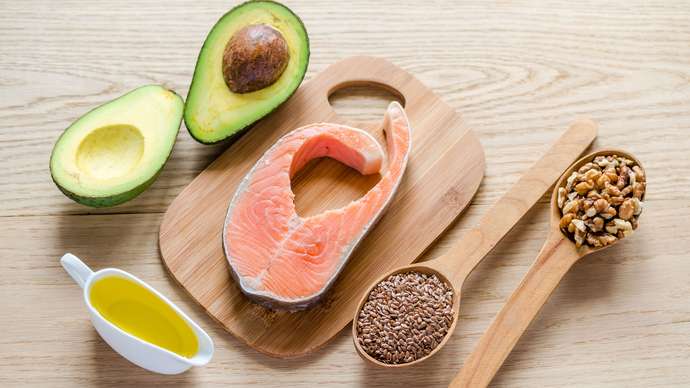- PhentermineLearn more about phentermine and how to get the most from your weight loss journey.
- ResourcesAdditional information and tools to help you make the most of your effort.
- AlternativesLearn more about the most popular weight loss medications and science-backed supplements
Why Choose Unsaturated Fats?
Published on December 12, 2024

Lately, there’s been a whole lot of chatter about whether eating less fat can actually help you slim down. Folks are curious, can giving up on fatty foods truly make a scale-tipping difference? But hold up, there’s even more to the story! People are digging deep, trying to uncover if some fats are really the villains causing us to pack on pounds, along with nasty stuff like heart issues, the dreaded C, blood sugar woes, and various other health snags.
For the longest time, you have been told to stay away from fat because you have been told it is unhealthy. This is partially true as certain types of fats may increase your risk of serious health conditions. However, if consumed in moderation, some fats like the unsaturated type are essential and good for the body.
What Are Fats?
Fat is a nutrient. It is crucial for normal body function, and without it, we could not live. Not only does fat supply us with energy, it also makes it possible for other nutrients to do their jobs. Eating fat is important for many reasons, including:
- To absorb fat-soluble vitamins like vitamins A, D, E and K
- To provide energy
- To cushion our organs
- For growth and development
- To make hormones
- Because it’s essential for a healthy brain, which is about 60 to 70 percent fat
- To provide essential fatty acids that our bodies can’t make on their own
Fats, which consist of a wide group of compounds, are usually soluble in organic solvents and insoluble in water.
What Are Unsaturated Fats?
Unsaturated fats, which include monounsaturated and polyunsaturated fats, are liquid at room temperature. They are mostly derived from plant oils and are classed as “good” fats:
1. Monounsaturated Fats
Monounsaturated fatty acids, or MUFAs, are a type of unsaturated fat. “Mono,” meaning one, signifies that monounsaturated fats have only one double bond.
There are many different types of MUFAs. Oleic acid is the most common type, comprising around 90% of those found in the diet. Other MUFAs include palmitoleic acid and vaccenic acid.
Many foods are high in MUFAs, but most consist of a combination of different fats. There are very few foods that contain only one type of fat.
Foods that are highest in monounsaturated fats include:
- Olive oil
- Peanut oil
- Avocados
- Most nuts
- Most seeds
These different fats affect health and disease differently. Monounsaturated fats, in particular, have been shown to have a number of health benefits.
2. Polyunsaturated Fats
In polyunsaturated fats, there are a number of spaces around each polyunsaturated fat molecule – they are not saturated with hydrogen atoms.
The two major classes of polyunsaturated fats are omega-3 and omega-6 fatty acids. Nutritionists say that polyunsaturated fats are good for our health, especially those from fish, known as omega-3 polyunsaturated fatty acids. Both are essential fatty acids that your body needs for brain function and cell growth. Yet, your body cannot make essential fatty acids, so you may wish to get them from your diet.
Excellent sources of omega-3s include:
- Salmon
- Herring
- Sardines
- Mackerel
- Trout
- Bass
- Shrimp
Fish don’t produce omega-3 fatty acids on their own. Instead, they accumulate them by eating algae and small, microscopic organisms called plankton. You may also find omega-3s in pine nuts, walnuts, flax and sunflower seeds but these give a less active form of the fat than fish do.
The other type of polyunsaturated fats are omega-6 fatty acids. The oils highest in polyunsaturated fats include:
- Safflower oil
- Grapeseed oil
- Flaxseed oil
- Sunflower oil
- Poppy Seed oil
- Soybean oil
These oils are liquid at room temperature because the double bonds allow the fat to bend and fold.
Oil-based condiments like mayonnaise and salad dressings, as well as margarines, are also high in omega-6 polyunsaturated fats.
It is important to take note, however, that excessive intake of omega-6’s, which is common in the standard American diet, may lead to increased inflammation.
Health Benefits of Unsaturated “Good” Fats?
1. Weight Loss
All fats provide the same amount of energy — 9 calories per gram — while carbs and protein provide 4 calories per gram. Therefore, reducing the amount of fat in your diet can be an effective way to reduce your calorie intake and lose weight.
However, a diet with moderate-to-high amounts of monounsaturated fats can also help with weight loss, as long as you aren’t eating more calories than you’re burning. Studies have shown that when calorie intake remained the same, diets high in MUFAs led to weight loss similar to that of low-fat diets (1, 2).
Another study involving more than 120 overweight or obese people found that eating either a high-MUFA diet, approximately 20% of your total calories, or a high-carb diet for a year led to comparable weight loss of around 4 kilograms (3).
A larger study that combined the results of 24 other researches revealed that high-MUFA diets are slightly more effective than high-carb diets for weight loss (4).
Therefore, high-MUFA diets can be an effective way to lose weight when replacing other calories, rather than adding extra calories to the diet.
2. Healthier Heart
There is a big debate in nutrition about whether excessive saturated fats increase the risk of heart disease.
However, there is good evidence that increasing MUFAs in your diet can reduce risk factors for heart disease, especially if you’re replacing saturated fat.
Too much cholesterol in the blood is a risk factor for heart disease, as it can clog arteries and lead to heart attacks or stroke. Various studies have shown that a high intake of monounsaturated fats can reduce blood cholesterol and triglycerides.
A study involving more than 160 healthy people compared three months of a high-MUFA diet with a high-saturated fat diet to see the effects on blood cholesterol. Results showed that a diet high in saturated fat increased unhealthy LDL cholesterol by 4%, while the high-MUFA diet reduced LDL cholesterol by 5% (5). Other smaller studies have found similar results of MUFAs reducing LDL cholesterol and increase “good” HDL cholesterol (6, 7).
High-MUFA diets can help lower blood pressure, too. Patients with high blood pressure who took high-MUFA diet experienced lower blood pressure and reduced the risk of heart disease, compared to those who had a high-carb diet. Similar beneficial results in blood pressure have also been found in people with type 2 diabetes and metabolic syndrome.
However, it is important to note that the beneficial effects of high-MUFA diets are only seen when they replace saturated fat or carbs in the diet. Also, in each of these studies, the high-MUFA diets were part of calorie-controlled diets, meaning that adding extra calories to your diet through high-MUFA foods may not have the same benefits.
Omega-3 polyunsaturated fats are also renowned for their effects on heart health. Regular fish consumption and higher blood levels of omega-3s are well-linked with a lower risk of heart disease and heart-related death.
3. Reduced Cancer Risk
There is also some evidence that diets rich in MUFAs may help reduce the risk of certain cancers.
Many studies have examined whether men who eat a good amount of MUFAs have reduced or increased rates of prostate cancer, but the evidence remains unclear. Each of the studies examining the role of high-MUFA diets in prostate cancer has found different results. Some show a protective effect, some show no effect and others show a harmful effect (8, 9). One of these studies suggested that other components of high-MUFA foods may cause the protective effect rather than the MUFAs themselves. Therefore, it is unclear how MUFAs affect prostate cancer.
High-MUFA diets have also been studied in relation to breast cancer risk (10, 11). A study involving more than 640 women found that those with the highest amounts of oleic acid, a common type of MUFA found in olive oil, in their fat tissue had the lowest rates of breast cancer (12).
However, this was only seen in women in Spain where olive oil is widely consumed and not in women from other countries. This suggests it may be another component of olive oil that has a protective effect.
Moreover, all of these studies were observational, meaning they can’t prove cause and effect. Thus, other components of diet and lifestyle may be contributing to this beneficial effect.
4. Improved Insulin Sensitivity
Insulin is a hormone that controls your blood sugar by moving it from the blood into your cells. The production of insulin is important for preventing high blood sugar and type 2 diabetes. Studies have shown that high-MUFA diets can improve insulin sensitivity in both those with and without high blood sugar.
Evidence showed that eating a high-MUFA diet for three months improved insulin sensitivity by as much as 9% (13).
A similar, separate study of more than 470 patients with metabolic syndrome found that those who ate a high-MUFA diet for 12 weeks had significantly reduced insulin resistance (14).
Other studies have found similar beneficial effects of high-MUFA diets on insulin and blood sugar control (15, 16).
5. Less Inflammation
Inflammation is a normal immune system process that may help your body fight infection. But sometimes inflammation happens slowly over a long period of time, which can contribute to chronic diseases like obesity and heart disease. Compared to other diets, such as high-saturated fat diets and Western diets, high-MUFA diets can reduce inflammation.
Evidence showed that high-MUFA diets can help lessen inflammation in patients with metabolic syndrome, compared to high-saturated fat diets (17).
Other studies have shown that people who eat a Mediterranean diet high in MUFAs have significantly lower inflammatory chemicals in their blood, such as C-reactive protein (CRP) and interleukin-6 (IL-6) (18, 19).
High-MUFA diets can also reduce the expression of inflammatory genes in fat tissue compared to high-saturated fat diets. This may be one of the ways that MUFAs are helpful for weight loss (20).
By reducing inflammation, high-MUFA diets may help to reduce the risk of chronic diseases.
6. Good Infant Development
Mothers who consume 227–340 grams of fatty fish per week during pregnancy and breastfeeding may have healthier children.
Evidence showed that the children of mothers who consumed fish more than twice per week performed higher on language and visual motor skills tests than children whose mothers did not regularly consume fish (21).
Another study noted that the children of mothers who ate 340 grams of fish per week were less likely to have issues with behavioral, fine motor and communication skills (22).
It’s recommended that pregnant or breastfeeding women consume weekly at least 227 grams but no more 340 grams of fish low in mercury, a heavy metal that can impair fetal development.
Pregnant women should limit or avoid fish with the highest mercury levels, including marlin, orange roughy, swordfish, tuna, king mackerel and shark.
7. Better Mental Health
Omega-3 fatty acids are crucial for brain development and function. Eating fish, which is high in DHA may help prevent mental decline and related illnesses.
In a five-year study in more than 200 older men, fish consumption was associated with less mental decline (23). Another study involving more than 5,000 people showed that higher fish consumption was tied to a 60% lower risk of dementia and a 70% lower risk of Alzheimer’s disease over an average of two years (24).
What’s the Recommended Levels of Fat Intake?
People need fats, so you don’t have to do without them. However, regulatory authorities recommend that you eat saturated fat in moderation.
The American Heart Association recommends limiting your intake of saturated fat to less than 6 percent of your daily calories. That translates to about 120 calories, or about 13 grams per day on a 2,000-calorie daily diet.
Total fat intake should be between 20 and 35 percent, which is equal to 44 to 77 grams of total fat daily on a 2,000-calorie diet.
However, research shows that certain higher fat diets, such as the Mediterranean diet, and low-carbohydrate diets are beneficial for overall health. Ultimately, your energy needs, genetics, and lifestyle are the best indicators of your macronutrient needs.
Tips to Start Eating Healthier Fats
Focus on replacing foods high in saturated fat with foods that include monounsaturated fats and polyunsaturated fats.
Try these tips to make over the fat in your diet:
- Avoid trans fats by checking food labels and look for the amount of trans fat listed. By law a serving of food containing less than 0.5 grams of trans fat can be labeled as 0 grams. Therefore, it’s important to also check ingredient lists for the term ʺpartially hydrogenated.֞
- Prepare fish, such as salmon and mackerel, instead of meat at least twice a week to get healthy omega-3 fatty acids. Bake or broil seafood instead of frying it.
- Choose lean meat and skinless poultry. Trim visible fat from meat and poultry, and remove skin from poultry.
- Choose a diet rich in whole grains, fruits, and vegetables.
- Try a vegetarian meal, with plenty of beans, once a week.
- Select dairy products that are skim or low-fat.
- Experiment with light and reduced-fat salad dressings.
- Replace fattier sauces with vinegars, mustards, and lemon juice.
- When using fats, do so sparingly. Try to use unsaturated liquid oils, such as canola or olive, instead of butter or partially hydrogenated margarine.
- Limit your consumption of high-fat foods, such as processed foods, fried foods, sweets, and desserts.
- When cooking, substitute the lower-fat alternative. For example, low-fat sour cream or low-fat cream cheese whenever possible.
Keep in mind that most foods contain a mix of different kinds of fat and varying levels of each type. Don’t get bogged down in the details. Instead, focus on choosing foods that contain unsaturated fats, instead of foods that contain saturated or trans fats. For example, canola oil contains some saturated fat but is mostly monounsaturated fat. It’s a great replacement for butter, which contains some unsaturated fat but is mostly saturated fat.
The Bottom line
Always remember, moderation is key! Though research has revealed that not all fats are bad for your health, it is crucial to moderate your consumption of them because, while some fats are beneficial to, they are still high in calories. Begin your journey to a healthier you by incorporating more monounsaturated and polyunsaturated fats in replacement of your saturated fats consumption, and limiting trans fats from your diet intake. Do not forget to follow the recommended amount of daily intake too!
References:
(1) https://www.ncbi.nlm.nih.gov/pubmed/11673773
(2) https://www.ncbi.nlm.nih.gov/pubmed/7555486
(3) https://www.ncbi.nlm.nih.gov/pmc/articles/PMC2628682/
(4) https://www.ncbi.nlm.nih.gov/pubmed/27457635
(5) https://www.ncbi.nlm.nih.gov/pubmed/11317662
(6) https://www.ncbi.nlm.nih.gov/pubmed/14749224
(7) https://www.ncbi.nlm.nih.gov/pubmed/10615219
(8) https://www.ncbi.nlm.nih.gov/pubmed/10977105
(9) https://www.ncbi.nlm.nih.gov/pubmed/8105097
(10) https://www.ncbi.nlm.nih.gov/pubmed/8637339
(11) https://www.ncbi.nlm.nih.gov/pubmed/9437377
(12) https://www.ncbi.nlm.nih.gov/pubmed/9665107
(13) https://www.ncbi.nlm.nih.gov/pubmed/11317662
(14) https://www.ncbi.nlm.nih.gov/pubmed/26561628
(15) https://www.ncbi.nlm.nih.gov/pubmed/27434027
(16) https://www.ncbi.nlm.nih.gov/pubmed/21912106
(17) https://www.ncbi.nlm.nih.gov/pubmed/22707261
(18) https://www.ncbi.nlm.nih.gov/pubmed/15383514
(19) https://www.ncbi.nlm.nih.gov/pubmed/9989963
(20) https://www.ncbi.nlm.nih.gov/pubmed/19828712
(21) https://www.ncbi.nlm.nih.gov/pubmed/18353804
(22) https://www.ncbi.nlm.nih.gov/pubmed/17307104
(23) https://www.ncbi.nlm.nih.gov/pubmed/17413117
(24) https://www.ncbi.nlm.nih.gov/pubmed/9392577


